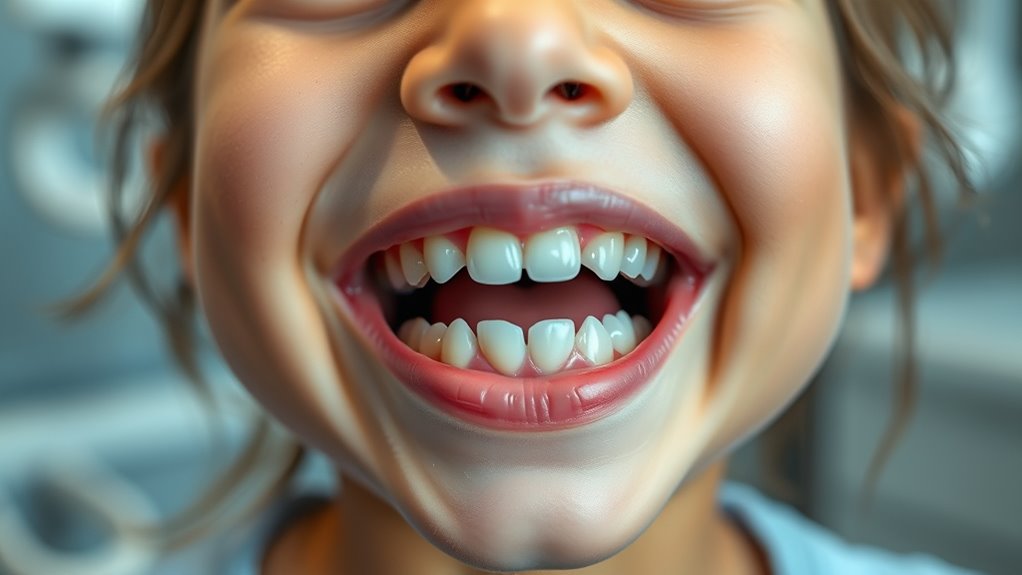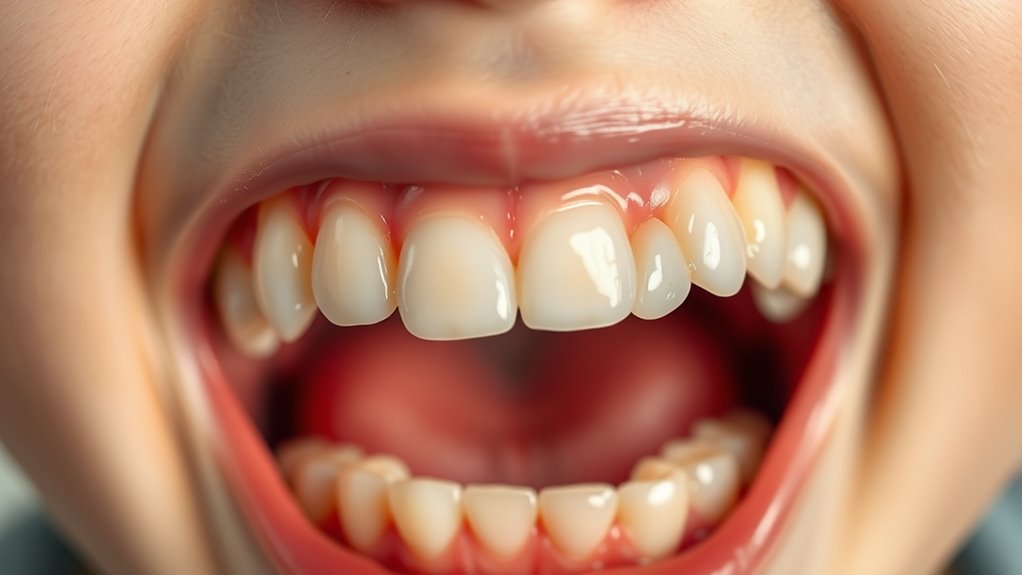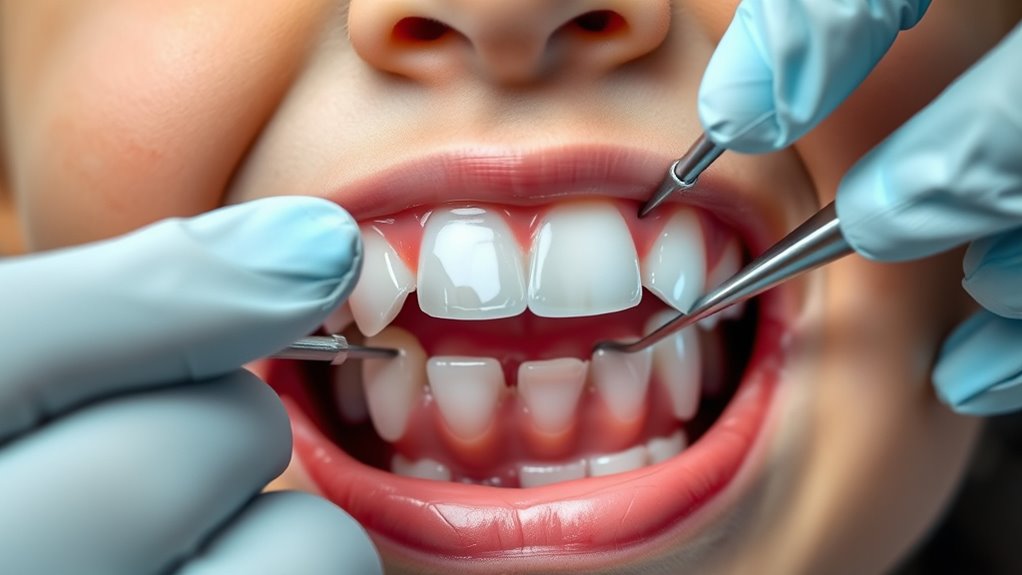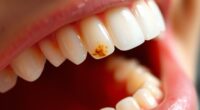Dental sealants create a protective barrier on your child’s molars, covering deep grooves and pits that are hard to clean. They markedly reduce the risk of cavities by preventing food particles and bacteria from reaching the tooth surface. The application is quick, painless, and safe, lasting up to 10 years with proper maintenance. By understanding how sealants work, you’ll discover why they’re a smart, cost-effective way to support your child’s long-term oral health.
Key Takeaways
- Dental sealants create a protective barrier on molars, preventing bacteria and food particles from causing cavities.
- They are quick, painless, and safe to apply, making them suitable for children’s comfort and cooperation.
- Sealants significantly reduce cavity risk, with studies showing up to 86% cavity prevention in children’s molars.
- They are cost-effective, lasting up to 10 years, and help lower future dental treatment expenses.
- Applying sealants soon after molars erupt supports lifelong oral health and cavity prevention.
How Sealants Provide a Protective Barrier for Children’s Teeth

Dental sealants act as a shield for your child’s teeth by covering the chewing surfaces of molars with a thin plastic coating. This creates a protective barrier that blocks food particles and bacteria from settling into the deep grooves, pitting, and fissures on children’s teeth.
Sealants fill in these areas, which are difficult to clean thoroughly with brushing alone, reducing the risk of tooth decay. When applied, the resin bonds securely to the tooth’s surface, sealing out harmful substances and preventing bacteria from accessing vulnerable spots.
Studies indicate that dental sealants can prevent cavities in children’s molars by up to 86% within the first year. By forming this barrier, sealants play an essential role in cavity prevention and maintaining your child’s oral health.
The Role of Sealants in Preventing Cavities in Young Smiles

Sealants play an essential role in safeguarding your child’s teeth from cavities by creating a protective barrier on the biting surfaces of molars. Dental sealants prevent cavities by sealing deep grooves and pits that are hard to clean, where bacteria and food particles often get trapped.
When you opt for sealant application on your child’s newly erupted permanent molars, it markedly reduces their risk of decay. Studies show that children with sealants experience an 86% reduction in cavities after one year and a 58% reduction after four years, highlighting their long-term effectiveness.
These sealants act as a barrier, preventing bacteria from settling into the tooth surface and promoting better oral health. Regular dental visits ensure the sealants stay intact, offering continuous cavity protection during these vulnerable years.
Why Sealants Are Most Effective on Molars and Back Teeth

Because molars and back teeth have deep grooves and pits that are hard to clean, they’re more vulnerable to cavities. These areas trap food and bacteria, increasing decay risk. Sealants are most effective on molars because they fill in these deep grooves, creating a smooth surface that’s easier to clean and less prone to decay. Applying sealants soon after the molars erupt—around ages 6 and 12—provides targeted decay prevention where it’s needed most. Since molars endure the greatest biting pressure and are more susceptible to cavities, sealants offer vital protection. They act as a barrier against food particles and bacteria, reducing the likelihood of decay in hard-to-reach areas. Additionally, understanding dental material durability helps ensure that sealants provide long-lasting protection against cavities. Using high-quality sealant materials can further extend their effectiveness over time, especially considering the importance of preppy dog names for style.
The Safety and Comfort of Applying Dental Sealants to Kids

Applying dental sealants is a quick, painless process that kids usually tolerate well. The materials used are safe and BPA-free, reducing health concerns. Since the procedure takes just a minute or two per tooth and involves no drilling or anesthesia, it’s a comfortable experience for children. Additionally, advanced dental materials can enhance the durability and effectiveness of sealants. Moreover, personalized learning paths driven by AI can help dental professionals educate children about oral health in engaging ways. Incorporating data-driven strategies can also help track the effectiveness of sealants over time and improve preventative care. Regular application of sealants, supported by clinical research, further boosts their protective benefits for children’s teeth.
Painless Application Process
Applying dental sealants to children is a quick and painless process that typically takes just 1 to 2 minutes per tooth. During the painless application, there’s no drilling, injections, or anesthesia involved, making the procedure comfortable for kids. A new sentence with safe application techniques and the rest of the sentence. The dentist first cleans and dries the tooth, then uses a mild acid solution to help the sealants bond better—all without causing discomfort. The sealant material hardens instantly under a special curing light, keeping the experience stress-free. Because the process is non-invasive and pain-free, children often feel more at ease during their dental visits. This smooth application encourages a positive attitude toward dental care, helping kids stay comfortable and relaxed while protecting their teeth effectively. Additionally, proper technique selection ensures that the application remains safe and effective for every child. Proper training and experience in sealant placement are essential for achieving optimal results. Furthermore, understanding sealant durability can help ensure long-lasting protection for your child’s teeth. Implementing these safe and effective application procedures contributes to a more pleasant experience for young patients.
Low BPA Exposure Risk
The painless and quick process of applying dental sealants is designed to keep children comfortable during their visits. Concerns about BPA exposure from dental sealants are understandable, but the truth is that the levels of BPA found in these resin-based sealants are very low and well below safety thresholds established by health authorities. The American Dental Association confirms that BPA exposure from sealants is infrequent and minimal, posing little risk to children’s safety or oral health. Modern formulations have substantially reduced BPA content, making sealants safer than ever. Additionally, ongoing research into cybersecurity vulnerabilities highlights the importance of technology safety measures, similar to efforts to ensure the safety of dental products. Regular dental evaluations help monitor sealant integrity and ensure ongoing safety, so you can feel confident that your child’s oral health is protected with minimal exposure to any potential risks from resin components. Advances in dental materials continue to improve the safety and effectiveness of sealants, and ongoing quality control ensures that these materials meet strict safety standards, providing peace of mind for parents and caregivers. Furthermore, advances in biocompatibility testing have contributed to the development of more secure dental sealant formulations, enhancing their safety profile. In addition, improvements in application techniques help minimize any potential exposure during the sealing process.
Quick, Child-Friendly Procedure
Because the process of applying dental sealants is quick and painless, children often find it easy to cooperate during their visit. The entire procedure takes only 1-2 minutes per tooth, making it a quick way to protect teeth without causing discomfort. There’s no need for anesthesia or drilling, which keeps it painless and stress-free for kids. The process involves cleaning and drying the teeth, then painting the sealant onto the surface and curing it with a special light—an easy, non-invasive step. Because it’s fast and painless, children are more likely to stay relaxed and cooperative. Additionally, applying sealants can be part of a comprehensive dental health plan that includes preventive care to maintain oral health. Using sealants as a preventive measure has been shown to significantly reduce the incidence of cavities in children’s molars. The application process also benefits from advancements in dental technology, making it safer and more efficient. This child-friendly procedure effectively safeguards teeth from cavities, providing a safe and comfortable way to keep young smiles healthy. Regular dental visits further enhance the protective benefits of sealants and promote overall oral health. Moreover, choosing appropriate materials for the sealants can improve their durability and effectiveness over time.
Durability and Maintenance of Children’s Sealants

Proper maintenance is essential to guarantee that your child’s dental sealants remain effective over time. Good oral hygiene, regular dental check-ups, and avoiding hard or sticky foods can significantly extend their lifespan. Sealants durability depends on careful care, and reapplication or repair might be needed if they chip or wear down. During dental visits, professionals monitor sealant integrity and perform reapplications when necessary. Consistent brushing and flossing help prevent damage and keep the sealants working their best. Understanding dental health maintenance and preventive care is important for long-term oral care success. Additionally, educating children about proper oral hygiene habits can foster lifelong protective practices. Proper sealant application techniques by dental professionals also play a crucial role in their longevity.
Cost-Effective Prevention: Saving Money With Sealants

By choosing sealants for your child’s teeth, you can lower future treatment costs by preventing cavities before they form. Most insurance plans cover sealants, making them an affordable way to protect your child’s smile. Using preventive dental care like sealants can also promote better oral health habits from a young age. Regular dental checkups can help ensure the sealants remain effective and your child’s teeth stay healthy. Additionally, the use of high-quality materials in sealants ensures longer-lasting protection. Understanding toilet maintenance and repairs highlights the importance of caring for preventive measures to keep them effective. Knowing how self watering plant pots operate can remind us of the importance of consistent, preventative measures in maintaining health—whether for plants or teeth. Investing in sealants now helps you save money on expensive dental procedures later on.
Lower Treatment Expenses
Dental sealants offer a cost-effective way to prevent cavities and avoid expensive dental treatments down the line. By applying dental sealants early, you can prevent cavities from forming, which helps protect teeth and reduces the need for costly fillings and restorations.
Most dental insurance plans cover sealant treatment for children, making it an affordable preventive dental option. The cost savings from sealants come from fewer visits for cavity repair and less need for extensive dental work later.
Sealants provide long-lasting protection, decreasing the frequency of dental visits for treatment and helping maintain your child’s oral health. Investing in preventive dental care like sealants not only saves money but also promotes healthier teeth for the future.
In addition, regular dental checkups can help identify early signs of decay or other issues, ensuring comprehensive dental care for your child’s well-being.
Preventative Cost Savings
Applying sealants is a smart, cost-effective way to prevent cavities and save money. This preventive measure reduces the need for costly dental treatments like fillings and crowns later on. Sealant application is proven to prevent up to 80% of cavities in molars, saving families hundreds of dollars over time.
Most dental insurance plans cover the cost, making it an affordable option for cavity prevention. Investing in sealants during early childhood helps avoid expensive procedures and discomfort associated with tooth decay. Regular maintenance and timely sealant application can extend the lifespan of your child’s teeth, further reducing future dental expenses.
Insurance Coverage Benefits
Most dental insurance plans cover the cost of sealants for children, making this preventive measure an affordable way to protect your child’s teeth. Insurance coverage encourages early intervention, helping you avoid costly dental treatments later.
Sealants are a cost-effective solution because they prevent cavities before they develop, reducing the need for fillings and restorations. Investing in sealants with insurance coverage offers affordable dental care and minimizes future expenses.
The low initial cost of applying sealants outweighs the expense of treating decay down the line, saving your family money over time. By taking advantage of coverage for this simple, preventive measure, you’re supporting your child’s oral health and reducing long-term dental costs, making sealants a smart, budget-friendly choice.
When and How to Get Sealants for Your Child’s Teeth

Knowing when to get sealants for your child’s teeth is essential for effective cavity prevention. Typically, the best time for sealant application is shortly after the permanent molars erupt—around age 6 for the first set and age 12 for the second set.
Proper sealant placement involves cleaning the child’s teeth, drying them thoroughly, and applying a mild acid etchant to prepare the surface. The sealant is then painted onto the grooves of the molars and hardened with a curing light.
To maximize protection, ensure all molars and premolars are sealed, even if they look healthy. Regular dental visits every six months allow your dentist to monitor the sealants’ integrity, reapply or repair as needed, and support your child’s oral hygiene.
Additional Benefits of Sealants for Long-Term Oral Health

Sealants don’t just protect your child’s teeth in the short term—they can provide long-lasting benefits that support overall oral health. When properly maintained, sealants can last up to 10 years, helping prevent cavities in molars and premolars. This early application supports long-term cavity prevention, reducing the need for invasive treatments later. Sealants work alongside good oral hygiene habits, enhancing dental care over time. Regular dental check-ups ensure their effectiveness, maximizing oral health benefits.
| Benefit | Description |
|---|---|
| Long-term cavity prevention | Sealants help protect teeth for years, reducing decay risks. |
| Cost-effective dental care | Preventing cavities avoids expensive treatments later. |
| Foundation for healthy teeth | Early application promotes lifelong oral health habits. |
Frequently Asked Questions
What Is the #1 Downside of Getting Sealants on Your Child’s Teeth?
The main downside of getting sealants on your child’s teeth is that they can chip or wear down over time, which means they might need reapplication or repair.
If not properly maintained, sealants can trap bacteria underneath, increasing decay risks.
They also lose effectiveness after about five years, so regular dental visits are essential.
Some kids might feel mild sensitivity or discomfort during or after the procedure.
Are Sealants Highly Recommended for Children?
Wondering if sealants are really recommended for your child? Absolutely! You play a key role in your child’s oral health, and sealants offer a simple, effective way to protect their teeth.
They markedly reduce the risk of cavities, especially on molars, and are quick, painless to apply. Dentists and pediatric dental associations strongly endorse them, making them a smart choice to keep your child’s smile healthy and cavity-free.
What Is the Best Age to Get Sealants?
You should consider getting dental sealants as early as possible after your child’s permanent molars erupt. The best age is between 6 and 14 years old, when the molars are new and vulnerable to cavities. Applying sealants during this window helps protect their teeth from decay.
If your child missed this window, older kids and teens can still benefit, especially if they’ve deep grooves or a history of cavities.
Are Tooth Sealants Worth It?
You might wonder if sealants are worth it, and the answer is yes. They’re a quick, painless way to protect your child’s molars from cavities, reducing the risk by over 80%.
Sealants are affordable, often covered by insurance, and last up to five years with proper care.
Investing in sealants now can save you money and prevent painful dental procedures later, making them a smart choice.
Conclusion
Thinking about sealants? They’re a simple, proven way to protect your child’s teeth from cavities and future dental problems. Some say sealants are just a cosmetic fix, but research shows they markedly improve long-term oral health. By acting as a barrier on those hard-to-clean back teeth, you give your child a healthier smile that can last a lifetime. So, consider sealants as a smart, cost-effective step toward their dental well-being.









